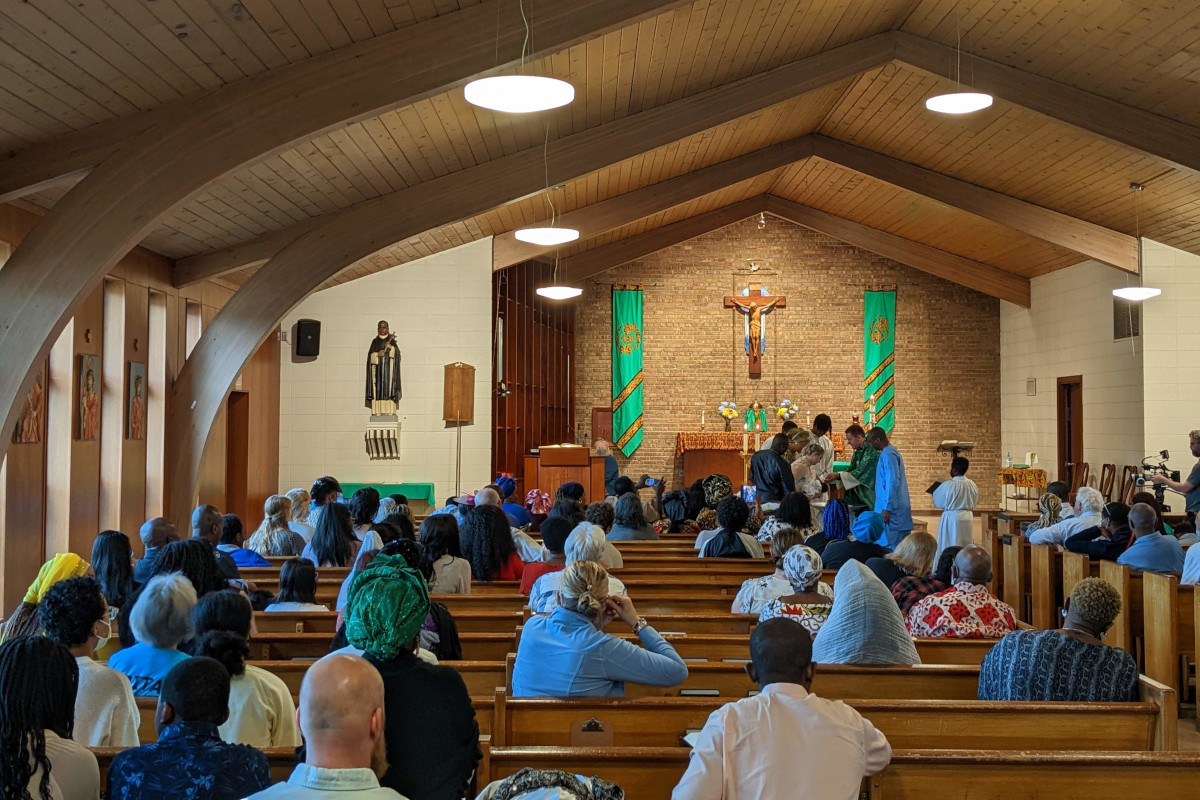
A baby is baptized at the Church of St. Peter Claver
Love of neighbor is not bounded in any way. We are called to invest in the well-being of all those in need, because every person is a beloved member of God’s kingdom. This year the Catholic Community Foundation of Minnesota (CCF) had discretion over $1.4 million in grants. Each grant aimed to support the spiritual, educational, or social needs of our community, focusing especially on investments in under-resourced communities.
Freedom to Stand
As a spiritual home for Black Catholics in the Archdiocese of Saint Paul and Minneapolis, the Church of St. Peter Claver in Saint Paul attracts worshippers from across the metro area. The parish’s broad reach, however, makes stability a challenge.
“The natural charism of Black culture for hospitality helps, but generally we schedule programming on weekends, when our parishioners are already here,” says Father Joseph Gifford, the parish’s pastor. “Communication is a challenge, as is stewardship. In the past we have relied on one-time gifts and grants. How can we take the next step toward a more sustainable model?”
An anonymous benefactor working with CCF recognized the need for a concerted push.
“There are few primarily Black parishes in our archdiocese, and we want to see them flourish,” says the donor. “If we’re serious about Black Lives Matter, we need more than lawn signs. We need real support.”
Inspired by the donor, CCF provided its own grant toward this effort and enlisted archdiocesan support. Through the Emil and Julia Wittman Memorial Fund, from which the Archbishop makes annual grants, the Archbishop invested in the initiative. Through this collaborative effort and with its own contribution, the parish created a new position — director of communications and stewardship — to strengthen community and engagement. Grant support will decrease as the position becomes self-sustaining.
“The universality of the Catholic Church is spoken when donors support a community like Peter Claver,” says Mike Essien, a parish trustee. “Kudos to CCF for seeing that. We thank them sincerely for helping us walk this journey forward.”
Strength in Diversity
In a lush corner of Maplewood, St. Jerome School nurtures souls. Principal Anne Gattman and her staff have made it their mission to provide a classical Catholic education to culturally diverse students.
“We have 90 percent students of color, and most fall well below the poverty line,” she says. “We serve a large number of Karen refugees from Myanmar (formerly Burma), as well as Hmong and African families.”
Diversity poses real challenges, Anne says, including financially supporting a school that serves families in need, welcoming people from different cultures and experiences, and teaching students who may not speak the same language. So, when CCF brought the Latino Enrollment Institute (LEI) to the archdiocese to help Catholic schools better serve Latino families, St. Jerome staff members were quick to sign up, knowing they had yet to begin recruiting and serving this portion of their community in earnest. “The LEI motivated us to find Latino Catholics in our community, but it also shared ideas for working with communities of different cultures like those we already serve,” Anne says.
“Latino families are our fastest-growing population, yet only 4 percent of this population is enrolled in Catholic schools,” says Katy Lichon, director of Catholic School Advantage at the University of Notre Dame. “We need to understand the imperative here.”
Katy and Anne agree that learning any second language is a strength and recruiting Latino families is additive.
“Once families trust that you have their best interests in mind, gifts are multiplied,” says Katy. “I commend CCF for knowing the need and helping local churches and schools make changes in their own space.”
Dignity in the Face of Challenges
Every night, nearly 5,000 Minnesota youth need a place to sleep. Most are people of color, and many struggle with mental health issues.
Hope Street for Youth provides a haven and remedy for youth ages 18 to 24 experiencing homelessness. A ministry of Catholic Charities of St. Paul and Minneapolis, the emergency shelter offers a safe space for up to 30 residents at a time. Most transition to permanent housing in less than 40 days.
According to Molly McInerny, senior program manager, Hope Street’s clientele challenge typical notions of homelessness.
“This demographic is very busy working, going to school, and socializing. Some work full-time jobs plus overtime,” she says. “Most people have somewhere to stay while they save money for housing. These young people don’t have that.”
This spring, CCF partnered with Catholic Charities and local governments to move Hope Street from the St. Joseph’s Home for Children campus to a former assisted living facility in the Hiawatha neighborhood of Minneapolis. The $6 million facility offers dignified private rooms, housing-focused case management, and more. The new shelter opened in June.
“People in the neighborhood had questions initially, but they ultimately said, ‘We want this program in our neighborhood,’” says Keith Kozerski, chief program officer. “The city, county, and partners like CCF came forward with very generous contributions. We have not seen this level of support, this easily, for many other programs.”
“It’s about promoting the common good for all people and practicing the words of Jesus Christ,” says Michael Goar, president and CEO of Catholic Charities of St. Paul and Minneapolis. “The mission of the Church lines up with the interests of our partners. This is an investment strategy for CCF and our government partners. Without these resources, the new Hope Street wouldn’t exist.”
